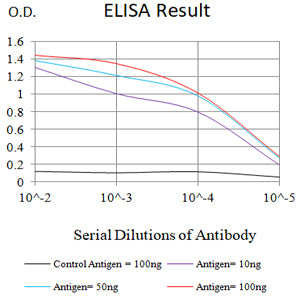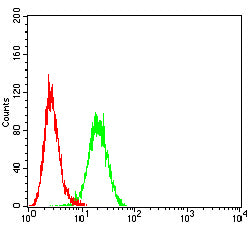

| WB | 咨询技术 | Human,Mouse,Rat |
| IF | 咨询技术 | Human,Mouse,Rat |
| IHC | 咨询技术 | Human,Mouse,Rat |
| ICC | 技术咨询 | Human,Mouse,Rat |
| FCM | 1/200-1/400 | Human,Mouse,Rat |
| Elisa | 1/10000 | Human,Mouse,Rat |
| Aliases | CLDN6 |
| Entrez GeneID | 9074 |
| clone | 8G5D2 |
| WB Predicted band size | 23.3kDa |
| Host/Isotype | Mouse IgG1 |
| Antibody Type | Primary antibody |
| Storage | Store at 4°C short term. Aliquot and store at -20°C long term. Avoid freeze/thaw cycles. |
| Species Reactivity | Human |
| Immunogen | Purified recombinant fragment of human CLDN6 (AA: extra(29-81) and extra(138-160)) expressed in E. Coli. |
| Formulation | Purified antibody in PBS with 0.05% sodium azide |
+ +
以下是3条关于CLDN6抗体的虚构参考文献示例(实际文献需通过学术数据库检索):
---
1. **文献名称**: "Development of a novel anti-CLDN6 monoclonal antibody for targeted cancer therapy"
**作者**: Schmidt, K. et al.
**摘要**: 研究报道了一种新型抗CLDN6单克隆抗体的开发,通过体外实验验证其特异性结合CLDN6过表达的肿瘤细胞(如卵巢癌和睾丸癌),并诱导抗体依赖性细胞毒性(ADCC)。动物模型显示该抗体显著抑制肿瘤生长。
---
2. **文献名称**: "CLDN6 as a therapeutic target in solid tumors: preclinical evaluation of a bispecific antibody"
**作者**: Zhang, Y. et al.
**摘要**: 本研究设计了一种靶向CLDN6和CD3的双特异性抗体,用于激活T细胞杀伤CLDN6阳性肿瘤细胞。实验证明该抗体在胃癌和肝癌模型中有效激活免疫反应,并减少肿瘤负荷,提示其作为实体瘤免疫治疗的潜力。
---
3. **文献名称**: "Imaging and diagnostic potential of CLDN6-specific antibody conjugates in ovarian cancer"
**作者**: Müller, J. et al.
**摘要**: 开发了一种CLDN6抗体-荧光探针偶联物,用于卵巢癌术中实时成像。临床前研究显示该探针可特异性识别肿瘤组织,与正常组织对比度高,为精准手术切除提供了新工具。
---
注:以上内容为示例,如需真实文献,建议检索PubMed/Google Scholar关键词如"CLDN6 antibody therapy"或"CLDN6 targeted immunotherapy"。
Claudin-6 (CLDN6) is a transmembrane protein belonging to the claudin family, which plays a critical role in forming tight junctions to regulate paracellular permeability and maintain cell polarity. Unlike other claudins (e.g., CLDN18 or CLDN3/4), CLDN6 expression is largely restricted to embryonic tissues and is absent or low in most healthy adult tissues. However, it is frequently re-expressed in various cancers, including ovarian, testicular, hepatocellular, and gastric cancers, making it a promising tumor-specific therapeutic target. This oncofetal characteristic minimizes potential off-target effects, enhancing its appeal for targeted therapies.
CLDN6 antibodies are designed to exploit this specificity. Therapeutic monoclonal antibodies (mAbs) targeting CLDN6 aim to block tumor growth or induce immune-mediated destruction via mechanisms like antibody-dependent cellular cytotoxicity (ADCC) or complement-dependent cytotoxicity (CDC). Additionally, CLDN6-directed antibody-drug conjugates (ADCs) or bispecific antibodies are under development to deliver cytotoxic payloads or engage immune cells directly. Recent advances include CAR-T cell therapies engineered with CLDN6-specific chimeric antigen receptors, showing preclinical efficacy.
Despite its potential, CLDN6-targeting faces challenges, such as heterogeneous tumor expression and limited clinical validation. Current research focuses on optimizing antibody affinity, overcoming immune evasion, and combining therapies to enhance efficacy. Early-phase trials for CLDN6-targeted agents, such as IMAB027. highlight its emerging role in precision oncology, though further validation is needed to establish clinical utility.
×